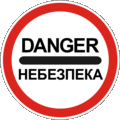Hazard facts for kids
A hazard is something that can be dangerous. It's anything that could cause harm to people, animals, or property. Think of it as a potential danger.

Many things can be hazards. For example, a fire is a hazard because it can burn things. Explosives are hazards because they can blow up. Even some everyday chemicals can be hazards if not handled carefully.
In places like driving schools, a "hazard" means something a driver needs to notice. They must drive safely because of it. For instance, children playing near a road are a potential hazard. If they run into the road, they become a real hazard. Drivers then need to react quickly and safely.
Contents
Understanding Different Types of Hazards
Hazards come in many forms. Some can cause fires, while others might burn your skin. Some can irritate your eyes or make you sick. Knowing the different types helps us stay safe.
Chemical Hazards
Chemicals can be very useful, but some are dangerous. They might be poisonous if swallowed. Others can cause burns if they touch your skin. Some chemicals can even explode or catch fire easily. Always read labels and follow safety rules when using chemicals.
Physical Hazards
Physical hazards are things in our environment that can cause harm. This includes things like sharp objects, loud noises, or extreme temperatures. Slippery floors are a physical hazard because you could fall. Heavy objects that might drop are also physical hazards.
Biological Hazards
Biological hazards come from living things. This could be harmful bacteria or viruses that make you sick. Mold in a damp place is a biological hazard. Even some plants or animals can be biological hazards if they are poisonous or carry diseases.
Safety Measures for Hazards
It's important to know how to deal with hazards. Often, there are ways to control them or remove them. This helps keep everyone safe.
Wearing Protective Gear
Sometimes, you can protect yourself by wearing special gear. For example, if you are working with chemicals, you might wear gloves and safety glasses. This helps prevent the chemicals from touching your skin or eyes.
Following Safety Rules
Many places have safety rules to prevent accidents. These rules are made to protect people from hazards. For example, a sign that says "Wet Floor" warns you of a slipping hazard. Following these warnings helps you stay safe.
Removing or Controlling Hazards
The best way to deal with a hazard is often to remove it. If you can't remove it, you might be able to control it. For instance, if there's a broken step, fixing it removes the hazard. If a chemical is dangerous, storing it in a locked cabinet controls the hazard.
Images for kids
-
In 1915, a traffic engineer warned that a proposed railroad crossing would be "the worse death trap in Los Angeles." This was because drivers couldn't see the train tracks clearly. Instead, a viaduct (an overhead bridge) was built to avoid this danger.
-
A boat wreck on rocks near Orchard Beach, New York, in the winter of 2007. The rocks were a hazard that caused the boat to crash.
-
A Ukrainian "danger" road sign. This sign tells drivers to stop for dangers like traffic accidents, natural disasters, or things blocking the road.
See also
 In Spanish: Peligro para niños
In Spanish: Peligro para niños



